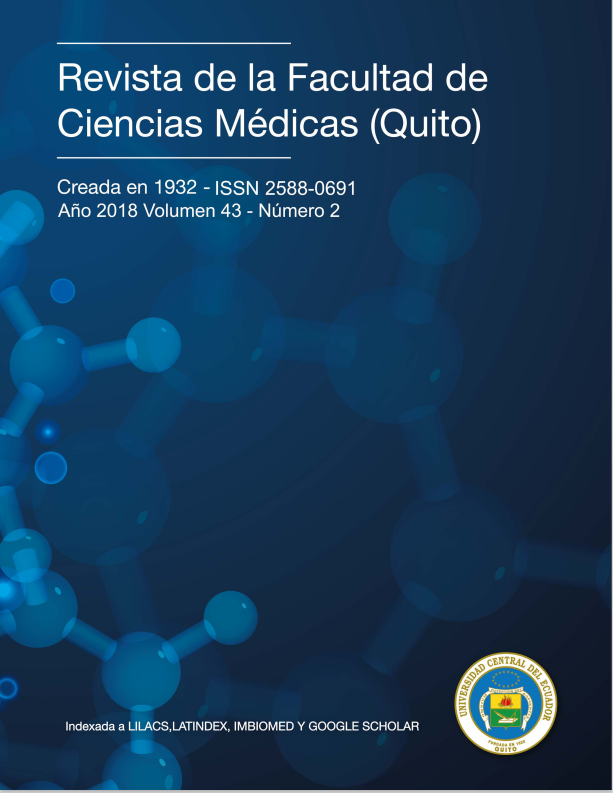Implementación de anestesia regional guiada por ultrasonido en el Hospital General Docente de Calderón
DOI:
https://doi.org/10.29166/rfcmq.v43i2.2829Keywords:
regional block, interscalenic block, supraclavicular block, femoral block, popliteal block, TAP blockAbstract
Technological advances in the field of Anesthesiology allow the use of ultrasound as diagnostic and therapeutic support in patients who require surgical intervention. The objectives of using diagnostic support methods include improving the safety and quality of both anesthetic and analgesic care. To incorporate imaging procedures into the daily activities of the anesthesiologist, it is necessary to include new knowledge, skills and abilities in the field of anatomy and basic aspects of ultrasound, to adapt to the use of a high frequency linear transducer and follow real-time images that facilitate the administration of the local anesthetic. The interest of the authors is to share two years of experience in the use of ultrasound for various types of regional blockages
Downloads
Metrics
References
Fanelli G, Casati A, Garancini P, et al. Nerve stimulator and multiple injection technique for upper
and lower limb blockade: failure rate, patient acceptance and neurologic complications. Study Group
on Regional Anesthesia. Anesth Analg 1999; 88:847–52.
Giaufre E, Dalens B, Gombert E. Epidemiology and morbidity of regional anesthesia in children: a
one-year prospective survey of the French-language society of pediatric anesthesiologists. Anesth
Analg 1996; 83:904–912.
Kapral S, Greher M, Huber G, et al. Ultrasonographic guidance improves the success rate of interscalene brachial plexus blockade. Reg Anesth Pain Med 2008; 33:253–8.
Franco CD, Viera ZE. 1001 subclavian perivascular brachial plexus blocks: success with a nerve stimulator. Reg Anesth Pain Med 2000; 25:41–6.
Koscielniak-Nielsen ZJ, Hesselbjerg L, Fejlberg V. Comparison of transarterial and multiple nerve
stimulation techniques for an initial axillary block by 45 ml of mepivacaine with adrenaline. Acta
Anaesthesiol Scand 1998; 42:570–5.
Aasbo V, Thuen A, Raeder J. Improved long-lasting postoperative analgesia, recovery function and
patient satisfaction after inguinal hernia repair with inguinal field block compared with general
anaesthesia. Acta Anaesth Scand 2002; 46:674-8.
Abad-Torrent A, Calabuig R, Sueiras A, et al. Efficacy of the ilioinguinal and iliohypogastric block in
the treatment of the postoperative pain of inguinal herniorrhaphy. Rev Esp Anestesiol Reanim 1996;
:318-20.
Petersen PL, Mathiesen O, Torup H, Dahl JB. The transversus abdominis plane block: a valuable option for postoperative analgesia? A topical review. Acta Anaesthesiol Scand 2010; 54:529–535.
Carney J, McDonnell JG, Ochana A, et al. The transversus abdominis plane block provides effective
postoperative analgesia in patients undergoing total abdominal hysterectomy. Anesth Analg 2008;
:2056–2060.
McDonnell JG, O’Donnell B, Curley G, et al. The analgesic efficacy of transversus abdominis plane block after abdominal surgery: a prospective randomized controlled trial. Anesth Analg 2007;
:193–97.
McDonnell JG, Curley G, Carney J, et al. The analgesic efficacy of transversus abdominis plane block
after cesarean delivery: a randomized controlled trial. Anesth Analg 2008; 106:186–191.
Downloads
Published
How to Cite
Issue
Section
License
Copyright (c) 2018 Manolo D Calero Robles, Jeanette M Mediavilla Sarmiento

This work is licensed under a Creative Commons Attribution-NonCommercial-NoDerivatives 4.0 International License.











